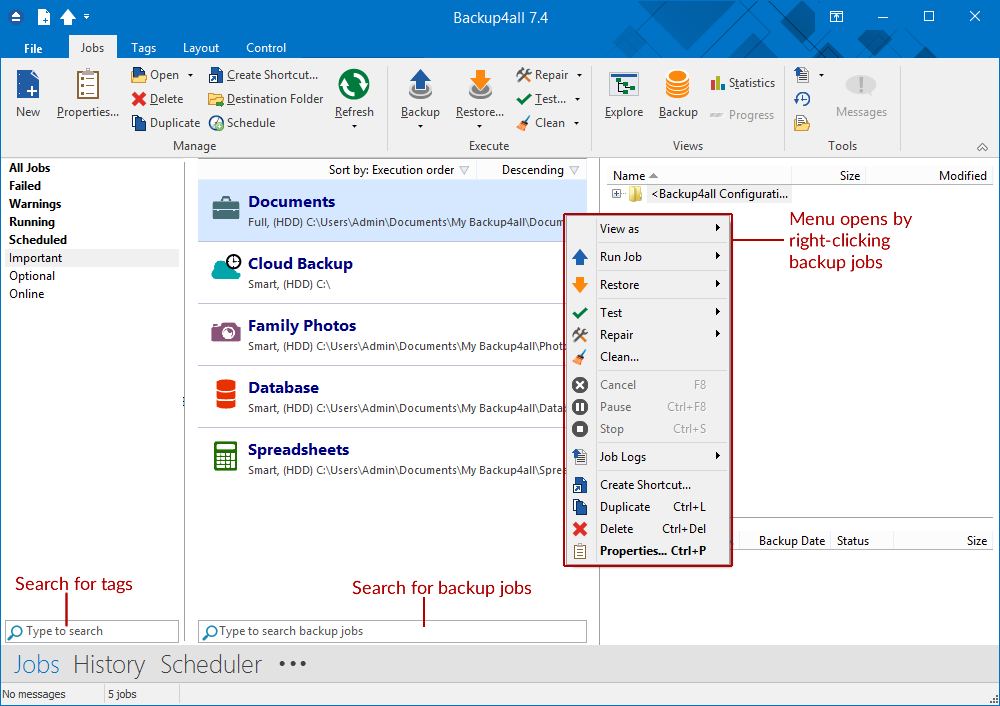The Backup list is the section visible in the middle column of the main window. It contains all the backup jobs defined that can be grouped into tags for easy handling. You can drag and drop backups in the list to re-order them.

To configure a backup job's appearance (icon and label) in the backup list, you have to open the Backup Properties window, switch to the General tab, change the name of the backup job, choose the tag/group of the backup job and select a backup job icon.
If you have several backup jobs defined in the same tag/group, you can check the option Sort jobs/tags alphabetically in Navigation Pane to have them ordered by name.
When you backup a tag, the backup jobs containing that tag are backed up in the order that they are displayed in the tag. You can drag and drop backups in the list to re-order them.
When right clicking a backup job, a menu is displayed giving the following options:
- View as - allows you to switch the jobs view between Card and List
- Run job - will open the following options list:
- Backup - performs the default selected backup type
- Full Backup - performs a full backup regardless of the backup type
- Differential Backup - performs a differential backup regardless of the backup type
- Incremental Backup - performs an incremental backup regardless of the backup type
- Later - allows you to set the backup to start with a given delay or at a specific time
- Restore - will open the following options list:
- Restore - opens the Restore Wizard window for the currently selected backup job
- Restore Latest Version - starts the latest version restore process for the selected backup job
- Restore Latest Version To - opens a window to select the folder were you want the backup to be restored
- Test
- Test... - starts the test process for the currently selected backup job.
- Quick test - starts the test process, but it only verifies the existence of the files in destination.
- Repair - will open the following options list:
- Repair - starts a test for all backup versions and then a backup, including all files missing in backup
- Repair Catalog Only - starts a test for all backup versions, removing from catalog all files missing in backup
- Quick Repair - use this option to repair the backup job in destination and re-copy all missing or corrupted files, based on the existing information in the backup catalog. A quick test will be performed, followed by a backup to also include the missing files.
- Quick Repair Catalog Only - use this option to remove from the backup catalog the missing or corrupted files in destination. A quick test will be performed, followed by a catalog update to remove the missing files.
- Clean - opens the Clean Backup window for the selected backup job
- Cancel - aborts current backup process
- Pause - pause the current backup/test/cleanup/restore process
- Stop - stops the current backup/test/cleanup/restore process
- Job Logs - lets you open and view the Last Backup Log, Last Restore Log, Last Test Log and Last Cleanup Log
- Create Shortcut... creates a shortcut to the backup job
- Duplicate - creates a copy of the backup job
- Delete - deletes a backup job
- Properties... opens the Backup Properties window for the selected backup job:
Backup4all can process multiple backup jobs at the same time. You can filter the backup list to see which backup jobs are executed at a certain time.
From the drop-down list above the backup list, you can filter the backup jobs in list. You can choose to see all jobs, only the running jobs, failed jobs or only the jobs containing a specific tag.
If there are many backups listed, you can search for a backup job by typing its name in the Type to search box on the bottom of the Backup List.


